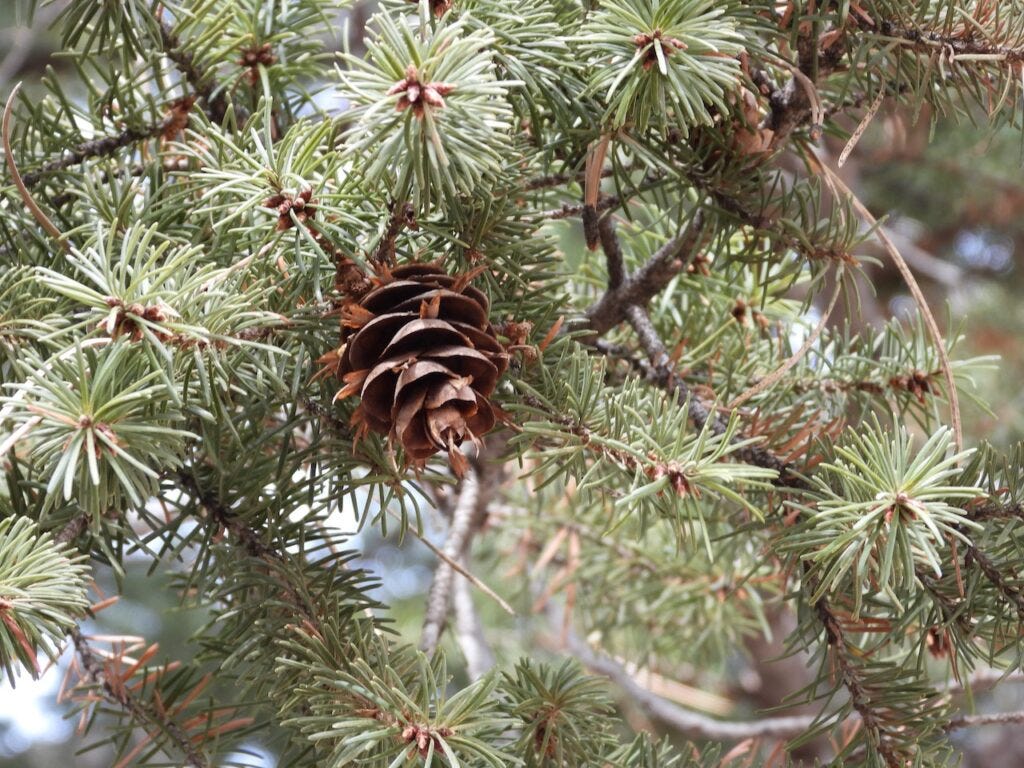Perhaps you are looking at a Douglas Fir in your house right now, this week before Christmas, decorated with lights and ornaments. Perhaps, if you live here in the Colorado Foothills, there are many around your property intermixed with Ponderosa Pines, Blue Spruce, and Lodgepole Pine. If you live up here, you can surely walk to a Douglas Fir within a short distance from your front door. Standing out among the other conifers, the Douglas Firs needles provide a friendly handshake. Their soft needles won’t cause you to jump with the stab of the sharp needles of other trees.
Last week, I was walking among the incredibly massive coastal trees of the Northwest. Surrounded by Red Wood, Sequoia, and the Douglas Fir. We stopped at the famous Mountaineer Tree, a 450-year-old Coastal Douglas Fir with a nearly 8-foot diameter trunk. Pictures give little sense of the size of the tree we stood beneath. Placing my hand on the bark, knowing this tree was alive at the same time as Shakespeare, has lived through so much Northwest history, and stands well over 200 feet high, has a reverent feeling of awe, and thanks.


The Mountaineer Tree is an old-growth, Coastal Douglas Fir. What I have on my land here in Colorado are Rocky Mountain Douglas Firs (Pseudotsuga menziesii var. Glauca—aka RM DougFir, as foresters and naturalists refer to them), the smaller cousin to the Coastal version. With logging here 100 to 140 years ago, our oldest trees are 200 years old at most. Here the trees receive far less humidity, which only allows them to grow to roughly half the size of their coastal cousins. Both have soft, one-inch needles growing spirally around the shoots.
The naming of this species is a convoluted story of debating biologists and botanists who, in the end, after 21 name changes, named it for the two botanists who first cataloged the tree and for what it is not! You might notice the term pseudo in the Latin name. Essentially, its name means Douglas and Menzies’s False Hemlock. Named for what it isn't. Taxonomy is a weird ride. So, the RM DougFir is a thing unto itself but related enough to other species to be linked as ‘not that’. Genetics, our modern method of determining species connections, shows that the DougFir is truly unique carrying an additional pair of chromosomes compared to other conifers. This adaptation seems to allow the DougFir to survive in vastly different climates and soils, from lava flows to rainforests, misty to arid.
The RM DougFir grows a shallower root system than the Ponderosa Pines, with roots extending down just 3-5 feet in depth and just 10-20 feet laterally. In comparison, the Ponderosa Pine’s roots have a 30-75 foot tap root straight down, and lateral roots that extend out up to 150 ft out and 6 feet down. It’s not surprising to see a tall Douglas fir tip over in a wind event, roots and all.
Mouse-tails
One of the most distinctive features of the RM DougFir is the little mouse-tail bract on the cones. A bract is essentially an additional leaf piece with the flower of a plant. Scientists have not determined a purpose for this small piece on the DouogFir yet, but in other plants, it can serve to make the flower stand out and attract pollinators.
The fact that the cones hang down is unique, and the sight of little mouse feet and tails poking out will cause you to remember it. One Indigenous story goes that during a very cold winter night, the tree invited a shivering mouse to take shelter in the cone. Soon other mice were filling the cones, causing them to hang, and overwhelming the tree. The tree became angry and so snapped shut trapping the little mice with their back feet and tails hanging out.
RM DougFirs grow straight trunks with strong wood. The bark begins in young trees as silver-colored and smooth. As the tree grows, the bark cracks and crags, developing deep canyons resembling a topographic map or aerial canyon photos. This straight, strong wood has been used by humans for building and fires for millennia. Indigenous people found medicinal uses in them as well. The timber industry recognized its value early on and logging has taken down much of the old-growth DougFirs in the American West. Houses, fences, furniture, cabinets, doors, plywood, flooring, and window frames were once tall Douglas Firs either Coastal or Rocky Mountain. Douglas Fir is one of the main seedlings replanted after a clear-cut.
Look up at the trees on your next walkabout. Find the short, soft needles with the little mouse-tails in the cones, give it a handshake, and thank a Douglas Fir for its gifts.
Sources:
- Douglas Fir: The Story of the World’s Most Remarkable Tree by Stephen F. Arno and Carl Fielder, Mountaineer’s Books, 2020
- https://sites.psu.edu/hort2022015/2015/04/15/douglas-fir-propagation/
- https://en.wikipedia.org/wiki/Pseudotsuga_menziesii_var._glauca
- https://www.stcnature.org/douglas-fir-the-mouse-tail-cones/








